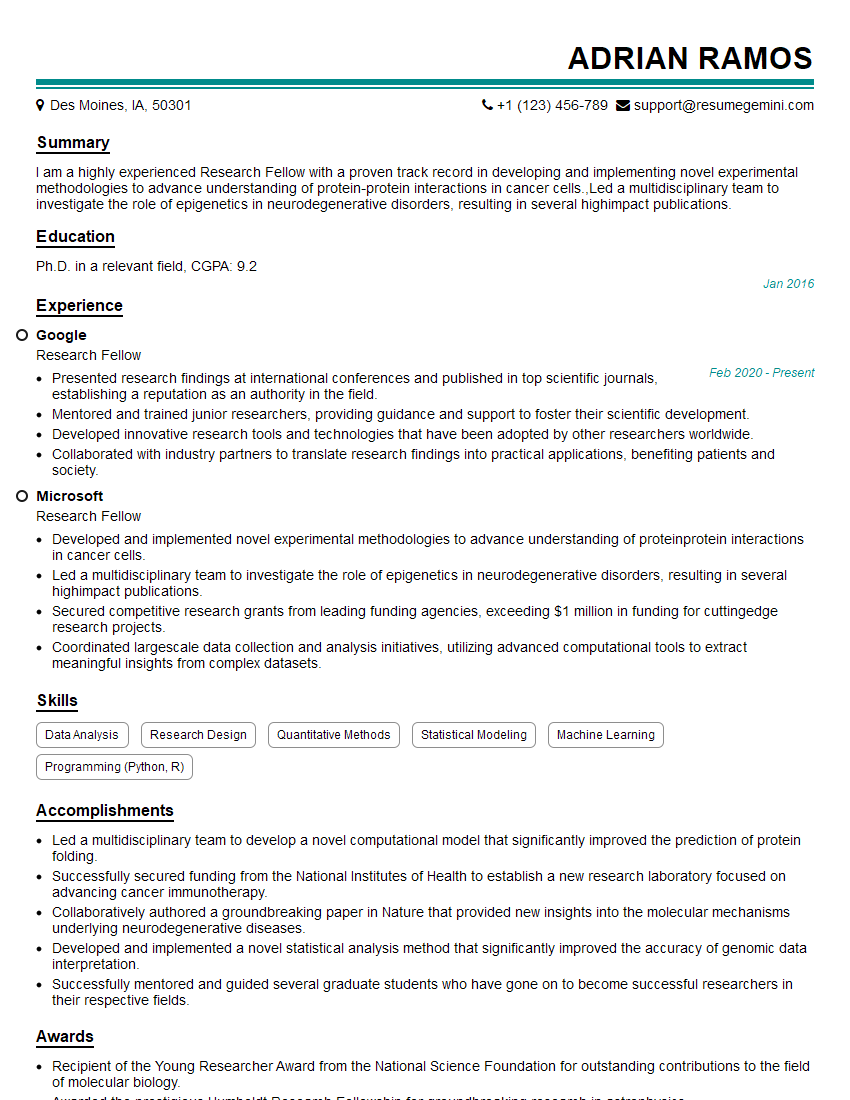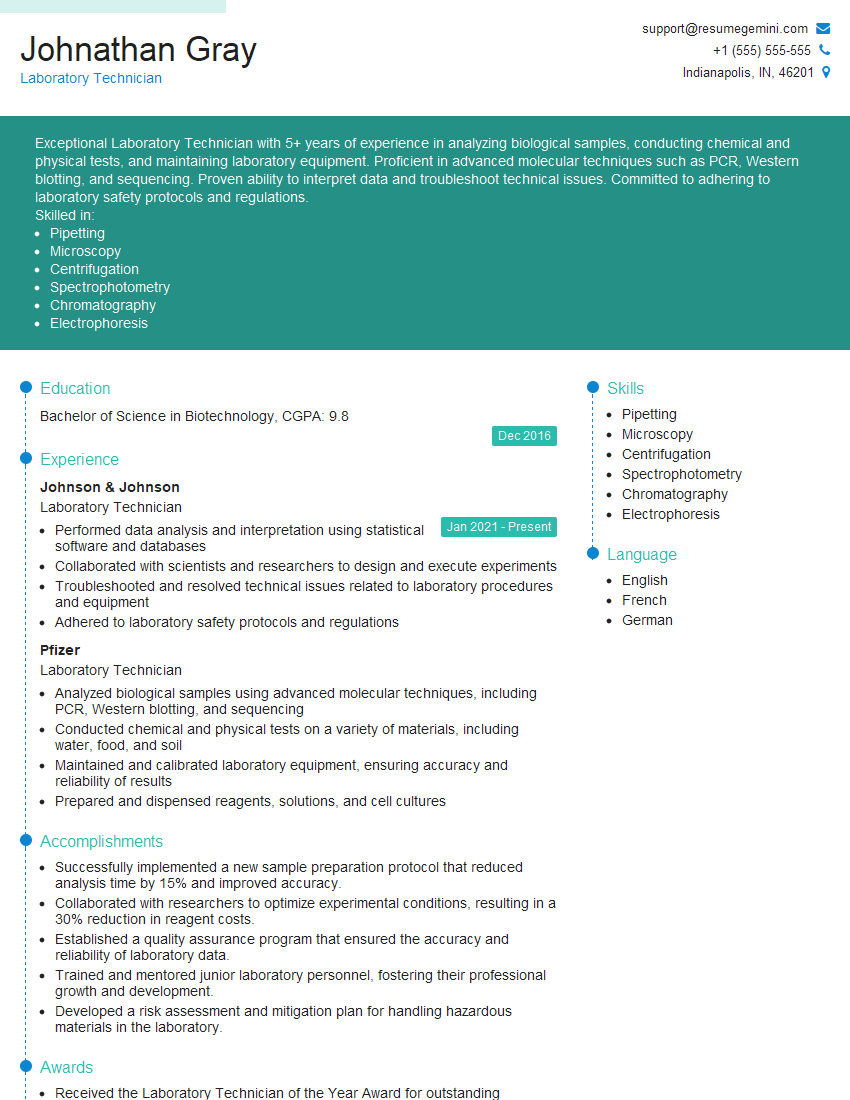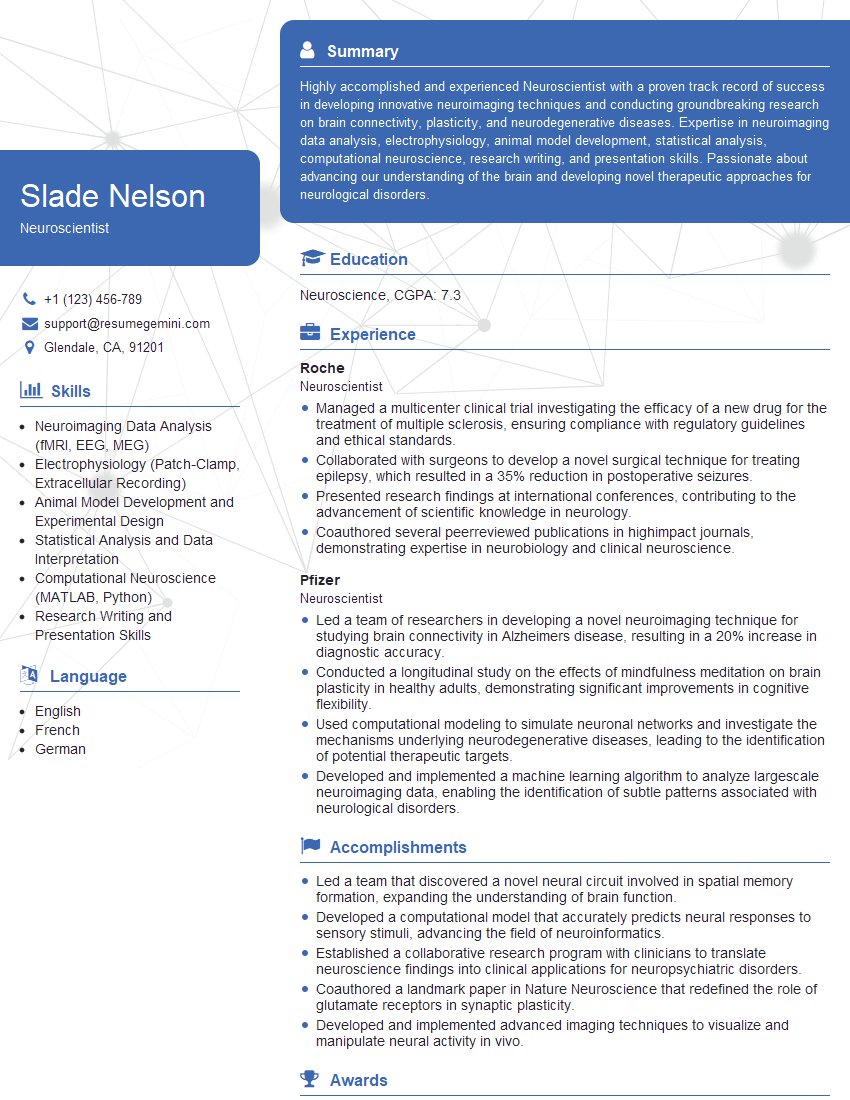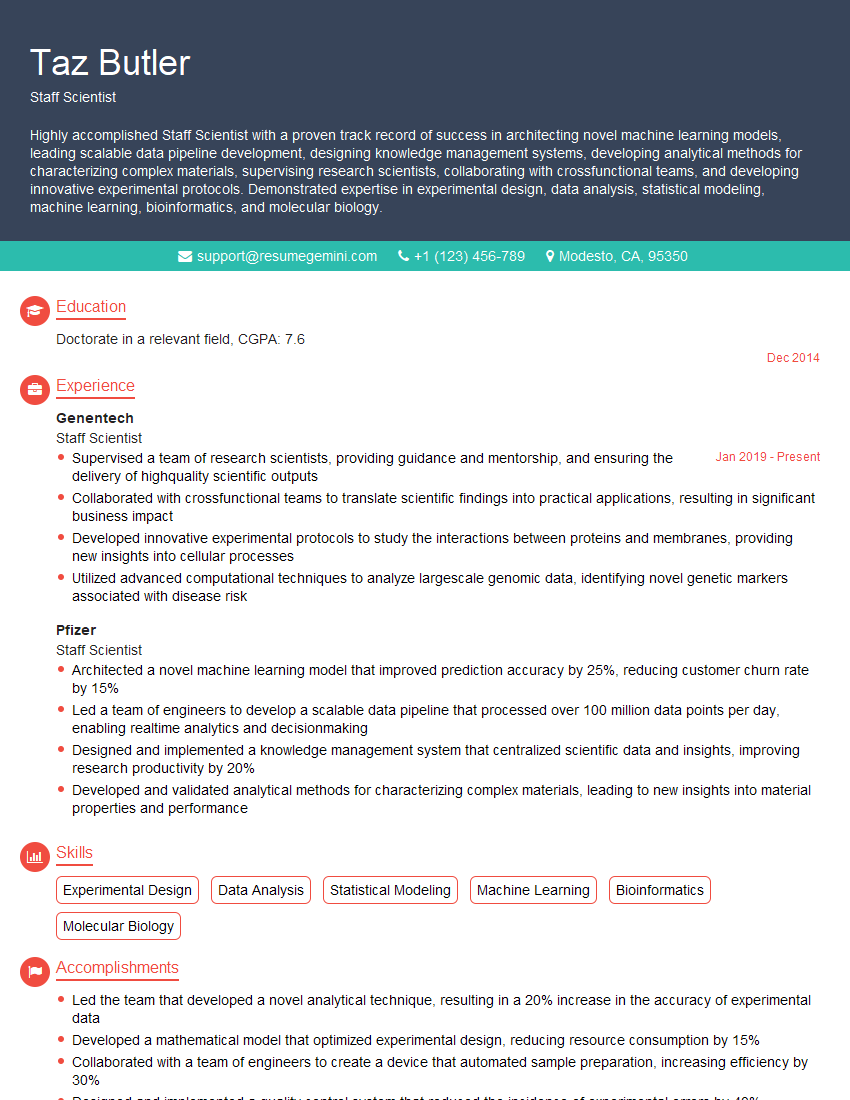Interviews are opportunities to demonstrate your expertise, and this guide is here to help you shine. Explore the essential Single-unit recording interview questions that employers frequently ask, paired with strategies for crafting responses that set you apart from the competition.
Questions Asked in Single-unit recording Interview
Q 1. Explain the principle behind single-unit recording.
Single-unit recording is a powerful electrophysiological technique used to measure the electrical activity of individual neurons. Imagine you have a vast orchestra; single-unit recording allows you to isolate and listen to the distinct sound of a single instrument, rather than the entire ensemble. The principle rests on the ability to place a microelectrode extremely close to a single neuron, so that its action potentials (the neuron’s ‘spikes’) are significantly larger in amplitude than the signals from neighboring neurons or background noise. This allows for the selective detection and recording of the activity of that specific neuron.
Q 2. Describe different types of electrodes used in single-unit recording.
A variety of electrodes are employed in single-unit recording, each with its own advantages and disadvantages. Common types include:
- Glass micropipettes: These are finely drawn glass tubes filled with an electrolyte solution, offering high impedance and excellent spatial resolution, allowing recordings from a single neuron. They are often used in in vivo preparations.
- Metal microelectrodes: These are typically made of tungsten, platinum-iridium, or other metals. They are more durable than glass micropipettes but might have slightly lower impedance, potentially leading to lower signal-to-noise ratio. They are commonly used in both in vivo and in vitro preparations.
- Silicon probes: These are multi-electrode arrays consisting of many small electrodes on a single probe. This allows for simultaneous recordings from multiple neurons, offering a higher throughput but potentially sacrificing the fine spatial resolution achievable with single electrodes.
The choice of electrode depends heavily on the experimental goals and the preparation being used (e.g., brain slice vs. awake behaving animal).
Q 3. What are the advantages and disadvantages of single-unit recording compared to other electrophysiological techniques?
Single-unit recording offers unparalleled resolution, allowing for the precise study of a single neuron’s firing patterns, temporal dynamics, and response characteristics. This level of detail cannot be easily achieved with other techniques like EEG or MEG, which provide population-level measurements. However, this high resolution comes at a cost. Single-unit recording is time-consuming, labor-intensive, and requires specialized expertise. It also typically involves invasive procedures, limiting the number of neurons that can be recorded simultaneously, whereas techniques like fMRI, while less precise at the single-neuron level, can provide a broader view of brain activity.
Advantages: High temporal and spatial resolution; ability to study the activity of individual neurons; detailed insights into neuronal coding.
Disadvantages: Invasive; time-consuming; limited number of simultaneously recorded neurons; requires specialized expertise; potential for damage to the recorded neuron.
Q 4. How do you identify and isolate a single neuron’s activity during recording?
Identifying and isolating a single neuron’s activity involves careful manipulation of the electrode and sophisticated signal processing techniques. First, the electrode is advanced into the brain tissue (in vivo) or brain slice (in vitro) until a clear increase in the amplitude of neuronal spikes is observed. Careful adjustment of the electrode position is crucial to ensure that the signal primarily originates from a single neuron. Visual inspection of the waveforms on an oscilloscope aids in this process. The presence of a clear, consistent spike shape (distinct from noise and activity of neighboring cells) helps in identifying the signal of a single neuron. Once a single neuron’s activity is detected, further signal processing steps such as spike sorting (detailed below) are employed for definitive isolation.
Q 5. Explain the process of spike sorting in single-unit recordings.
Spike sorting is a crucial step in single-unit recording to separate the activity of a single neuron from the background noise and the activity of other neurons. It involves analyzing the recorded waveform characteristics (amplitude, shape, and width) of each detected spike to group them into clusters, each representing the activity of a single neuron. This is often done using automated algorithms, but manual review and curation are usually required to ensure accuracy. Common algorithms include clustering techniques (e.g., k-means clustering) and template matching. Consider a ‘fingerprint’ analogy: each neuron’s spike has unique characteristics, enabling us to differentiate between neuronal sources. Successful spike sorting results in clearly separated clusters, each representing a distinct single neuron.
Example code snippet (Illustrative): While the specific code depends on the software used, the general approach involves using clustering algorithms on a feature matrix (e.g., principal component analysis for dimensionality reduction) to group spikes into clusters.
Q 6. What are common artifacts encountered in single-unit recordings, and how do you mitigate them?
Several artifacts can contaminate single-unit recordings, potentially leading to misinterpretations. These include:
- Movement artifacts: Movement of the electrode or the animal can generate spurious signals.
- Electrode drift: Over time, the electrode’s position relative to the neuron can shift, leading to changes in the signal amplitude.
- Electrical noise: External electromagnetic interference can contaminate recordings.
- Noise from neighboring neurons: Signals from nearby neurons can overlap with the desired signal.
Mitigation strategies include using stable electrode holders, applying appropriate grounding and shielding, careful electrode placement, using noise-reduction filters (both hardware and software), and employing sophisticated spike-sorting algorithms to separate the desired signal from noise. Proper experimental design and rigorous quality control are crucial to minimize these artifacts.
Q 7. Describe your experience with different data acquisition systems used in single-unit recording.
Throughout my career, I’ve had extensive experience with various data acquisition systems used in single-unit recording. These include systems from companies like Plexon, Neuralynx, and Intan Technologies. Each system has its own strengths and weaknesses regarding sampling rate, number of channels, and software capabilities. For example, Neuralynx systems are known for their robust hardware and versatile software for data acquisition and analysis; Intan systems often excel in high-channel count recordings, suitable for large-scale neuronal population studies. The choice of a system often depends on the specific experimental setup, budget, and desired functionalities. Regardless of the specific system, proper calibration and testing are crucial to ensure the reliability and accuracy of the recorded data. In my experience, focusing on the overall signal quality and data integrity is key, regardless of the specific data acquisition system employed.
Q 8. How do you ensure the stability and longevity of your single-unit recordings?
Ensuring stable and long-lasting single-unit recordings is crucial for reliable data. It’s a delicate balance of meticulous technique and careful consideration of the recording environment. Think of it like tending a delicate garden – consistent care is key to a bountiful harvest.
- Electrode stability: We use high-quality electrodes with a firm, yet gentle, placement. Micromotion of the electrode, even slight, can disrupt the signal. Sophisticated microdrives allow for precise adjustments and minimize movement. We often use specialized head-fixation systems to minimize animal movement during the recording session.
- Tissue health: Maintaining the health of the brain tissue is paramount. We use sterile techniques during surgery to minimize inflammation and damage. We also monitor vital signs throughout the recording, ensuring the animal remains healthy and stable. Excessive bleeding or swelling can easily compromise signal quality.
- Signal amplification and filtering: High-quality amplifiers and appropriate filtering are crucial. Amplifiers boost the weak neural signals, while filters remove noise from the recording. Think of it like isolating a specific instrument in an orchestra – you need to carefully adjust the amplification and filtering to hear the single instrument clearly.
- Data acquisition system: A stable and well-calibrated data acquisition system is also important to avoid artifacts and ensure accurate data capture. Regular checks and calibrations of the system ensure minimal electronic noise interference. This aspect is critical as even minor drifts in the system can be misinterpreted as a change in the neural signal.
By meticulously addressing these factors, we strive to obtain recordings lasting for hours, often extending to multiple days in some experimental paradigms. This detailed approach to recording stability directly contributes to the quality and reliability of our experimental results.
Q 9. What are the ethical considerations involved in animal models used for single-unit recordings?
Ethical considerations are paramount in using animal models for single-unit recordings. Our work is guided by the 3Rs: Replacement, Reduction, and Refinement. We strive to minimize the number of animals used (Reduction), explore alternative methods whenever possible (Replacement), and refine our procedures to minimize pain and distress (Refinement).
- Minimizing pain and distress: We use anesthesia and analgesics throughout the surgical procedures and during the recording session to minimize discomfort. Post-operative care is also crucial, including monitoring for signs of distress and providing appropriate treatment. We adhere strictly to institutional animal care and use committees (IACUC) guidelines and regulations.
- Justification of animal use: Every study must demonstrate clear scientific justification for the use of animals. The potential benefits of the research must outweigh the potential harm to the animals. A thorough review process, including peer review, ensures ethical considerations are central to every study design.
- Humane endpoints: We have predefined humane endpoints. If an animal shows signs of significant distress or pain that cannot be alleviated, the experiment is terminated immediately. The well-being of the animals is always prioritized.
- Transparency and accountability: All our work is conducted with complete transparency. We meticulously document all procedures, including pre-surgical preparation, the surgical process, recording, and post-operative care. This ensures full accountability and promotes ethical conduct.
Adhering to these high ethical standards is not simply a matter of compliance; it’s a fundamental aspect of our scientific integrity and commitment to responsible research.
Q 10. Explain your understanding of signal-to-noise ratio in single-unit recordings.
The signal-to-noise ratio (SNR) in single-unit recordings refers to the relative strength of the neural signal compared to the background noise. Imagine trying to hear a whisper in a noisy room. The whisper is your signal, and the background chatter is the noise. A high SNR means the signal is strong relative to the noise, while a low SNR means the signal is weak and hard to distinguish.
In single-unit recordings, the signal is the action potentials (spikes) fired by the neuron, and the noise includes various sources: thermal noise from the electrode and amplifier, movement artifacts, and background electrical activity from other neurons. A high SNR is essential for accurate identification and analysis of individual neuronal spikes.
We quantify SNR by various methods, including calculating the ratio of the peak amplitude of the spike to the root-mean-square (RMS) amplitude of the background noise. A higher ratio indicates a better SNR. We employ various techniques such as proper electrode placement, shielding, filtering, and averaging to enhance SNR. A low SNR often necessitates more complex analysis and can limit the reliability of the results.
Q 11. How do you analyze single-unit data using spike rate analysis?
Spike rate analysis is a fundamental method for analyzing single-unit data. It involves examining how often a neuron fires action potentials over time. Think of it as measuring the ‘firing rate’ of a neuron.
The process typically involves:
- Spike detection: First, we detect the spikes in the raw data using thresholding algorithms or more sophisticated spike-sorting techniques. This involves identifying voltage changes exceeding a predefined threshold to determine spike events.
- Spike counting: Once spikes are detected, we count the number of spikes within defined time bins (e.g., 1-second bins, 10-millisecond bins, etc.). The resolution of the time bin depends on the experimental question.
- Rate calculation: The spike count in each bin is then divided by the bin width to obtain the firing rate (spikes per second).
- Statistical analysis: We then use statistical tests to compare spike rates under different experimental conditions (e.g., before and after a stimulus, under different behavioral states) to determine if the differences are statistically significant.
For example, we might examine changes in the neuron’s firing rate during a specific task to determine its role in that behavior. Or, we might compare firing rates across different pharmacological manipulations to understand the effects of certain drugs on neural activity. Statistical significance of these comparisons is often determined using t-tests, ANOVAs, or other appropriate tests, depending on the experimental design.
Q 12. Describe your experience with different types of spike waveform analysis.
Spike waveform analysis focuses on the shape and characteristics of individual action potentials. It is a powerful tool for isolating and classifying different neurons recorded simultaneously using a single electrode.
I have experience with several methods:
- Principal Component Analysis (PCA): PCA is a dimensionality reduction technique used to identify the main components of variation in the spike waveforms. It helps in visualizing the clustering of different neuron waveforms in a lower-dimensional space.
- Waveform clustering: This involves using algorithms like k-means clustering or hierarchical clustering to group spikes with similar waveforms, assigning each cluster to a separate neuron.
- Template matching: This method uses a template (a representative waveform) for each identified neuron and matches incoming spikes to those templates to classify individual spikes to specific neurons.
The choice of method depends on the complexity of the recording and the number of neurons recorded simultaneously. These analyses are crucial for separating the signals of multiple neurons that may be recorded through a single electrode, thus ensuring that the subsequent analyses are conducted on single-unit activity rather than a mixture of multiple neurons. Visualization tools and software packages are indispensable in evaluating and interpreting the results of these analyses.
Q 13. Explain your experience with peri-stimulus time histogram (PSTH) analysis.
Peri-stimulus time histogram (PSTH) analysis is a powerful technique to examine the temporal relationship between a stimulus and the neuronal firing pattern. Imagine plotting how a neuron responds over time following a specific event or stimulus.
We create a PSTH by dividing time into small bins (e.g., 1-millisecond bins) relative to the onset of the stimulus and counting the number of spikes occurring in each bin across many repetitions of the stimulus. The result is a histogram showing the average firing rate of the neuron as a function of time around the stimulus.
This allows us to determine:
- Latency of response: How long after the stimulus does the neuron start to change its firing rate?
- Duration of response: How long does the neuron continue to respond to the stimulus?
- Pattern of response: Does the firing rate increase or decrease? Are there multiple peaks in the response?
PSTHs provide a concise visual representation of the neuron’s temporal response characteristics, crucial for understanding how neurons process information over time, particularly when examining sensory processing or motor control.
Q 14. Describe your experience with cross-correlation analysis in single-unit recordings.
Cross-correlation analysis helps determine the relationship between the firing patterns of two or more neurons. It reveals whether the neurons fire synchronously, sequentially, or independently. Imagine two musicians playing together – are they perfectly in sync, or are they playing at different tempos?
The cross-correlation function quantifies the similarity of the firing patterns of two neurons as a function of time lag. A peak at a specific time lag indicates that the two neurons fire together with that time difference. A positive correlation indicates that the neurons tend to fire together, whereas a negative correlation indicates that their firing is inversely related. A flat correlation indicates that there is no significant relationship between their firing patterns.
In practice, we use cross-correlation to investigate:
- Synaptic connectivity: Identifying potential synaptic connections between neurons. A significant peak at a short time lag might indicate a direct or indirect synaptic connection.
- Network interactions: Understanding functional interactions between neurons within neural circuits.
- Phase locking: Determining whether the firing of two neurons is synchronized with the phase of an ongoing rhythmic activity.
Cross-correlation is a valuable tool for uncovering functional connections and interactions between neurons and understanding how information is encoded and processed within neural circuits.
Q 15. How do you identify different neuronal firing patterns (e.g., tonic, phasic, bursting)?
Identifying neuronal firing patterns involves analyzing the temporal distribution of action potentials. Think of it like listening to a drummer: a consistent beat represents a different pattern than sporadic bursts or a series of rapid strikes. We primarily distinguish between tonic, phasic, and bursting firing patterns.
Tonic firing: This is characterized by a relatively constant and sustained firing rate. Imagine a metronome ticking steadily. We would observe a relatively regular inter-spike interval (ISI) histogram with a clear peak. In data analysis, this would show up as a high, relatively narrow peak in the ISI histogram and a consistent firing rate across time.
Phasic firing: This involves short bursts of activity followed by periods of silence. This is like a drummer playing a short roll, then resting. The ISI histogram would show multiple peaks, indicating different durations of pauses between spikes. Often, phasic firing is related to specific events or stimuli.
Bursting firing: This pattern features clusters of action potentials (bursts) separated by periods of quiescence. This is similar to a drummer playing a series of quick beats, then pausing. The ISI histogram shows distinct clusters of short ISIs, separated by longer intervals. Bursting patterns often reflect complex network interactions.
Analyzing the inter-spike interval (ISI) histogram, autocorrelogram, and peristimulus time histogram (PSTH) are crucial techniques for distinguishing these patterns. These visualization tools help quantify the regularity and timing of neuronal firing.
Career Expert Tips:
- Ace those interviews! Prepare effectively by reviewing the Top 50 Most Common Interview Questions on ResumeGemini.
- Navigate your job search with confidence! Explore a wide range of Career Tips on ResumeGemini. Learn about common challenges and recommendations to overcome them.
- Craft the perfect resume! Master the Art of Resume Writing with ResumeGemini’s guide. Showcase your unique qualifications and achievements effectively.
- Don’t miss out on holiday savings! Build your dream resume with ResumeGemini’s ATS optimized templates.
Q 16. How do you assess the health and stability of a recorded neuron?
Assessing the health and stability of a recorded neuron is critical for ensuring data reliability. We look for several key indicators.
Signal stability: A healthy neuron will exhibit a consistent signal amplitude and waveform shape throughout the recording. Drifting signal amplitude or changing waveform morphology suggests instability. We monitor the signal continuously and use automated quality control measures.
Consistent firing characteristics: A stable neuron will maintain a consistent firing pattern unless there’s a specific experimental manipulation. Sudden, drastic changes in firing rate or pattern can suggest a problem.
Absence of artifacts: Movement artifacts or electrical noise can easily contaminate the signal. We carefully filter the data and visually inspect it for any artifacts that might be misidentified as neuronal activity. A clear understanding of the experimental setup and noise sources is essential.
Spike sorting quality: If using extracellular recordings, proper spike sorting is crucial. Poor spike sorting can lead to contamination of single-unit data with activity from other neurons. We carefully review the clusters in our spike sorting to make sure they are well-separated and represent individual neurons.
Regular checks throughout the recording process, along with appropriate data analysis techniques, ensure we only use data from healthy, stable neurons.
Q 17. What are the limitations of single-unit recording?
Single-unit recordings, while powerful, have limitations.
Sampling bias: We only record from a small subset of neurons. This can lead to an incomplete picture of neural processing. It’s like trying to understand an orchestra by only listening to one instrument.
Invasiveness: In many cases, single-unit recording requires invasive procedures, limiting the applicability and ethical considerations, particularly in human subjects.
Technical challenges: Maintaining a stable recording over an extended period can be challenging due to electrode movement or tissue damage. We must consider the trade-off between long recording durations and risk of damage.
Limited spatial information: Single-unit recordings provide limited information about the spatial extent of neuronal activity. While we can infer some functional connectivity, the lack of spatial resolution prevents a full understanding of the neural network.
Data interpretation: Interpreting single-unit data requires careful consideration of the experimental context and statistical methods used. Misinterpretations can easily occur without careful data analysis.
Q 18. Describe your experience with different data visualization techniques for single-unit data.
I have extensive experience with several data visualization techniques, including:
Raster plots: These display the timing of spikes for each trial, providing a clear visualization of firing patterns in response to stimuli.
Peri-stimulus time histograms (PSTHs): These show the average firing rate over time relative to a specific event or stimulus. They help highlight patterns of neuronal activity aligned with stimuli or behaviors.
Inter-spike interval (ISI) histograms: These show the distribution of intervals between successive spikes. They reveal information about firing regularity.
Autocorrelograms: These visualize the correlation of neuronal activity with itself at different time lags. They can reveal oscillatory patterns and other temporal correlations in firing.
Spike waveforms and clustering plots: Essential in multi-unit recordings, these visualize individual spike waveforms to identify different units and assist in spike sorting.
Choosing the appropriate visualization method depends on the research question and data characteristics. For example, if we are investigating response to stimuli, PSTHs are ideal. If we are interested in the regularity of firing, ISI histograms are more informative.
Q 19. Explain your experience with statistical analysis of single-unit data.
Statistical analysis is fundamental to single-unit recording. I am proficient in several techniques, including:
Rate analysis: Calculating and comparing firing rates across different conditions or time points, often using t-tests, ANOVAs, or non-parametric equivalents.
Correlation analysis: Investigating relationships between the firing of different neurons or between neuronal activity and behavioral measures (e.g., using Pearson’s correlation or cross-correlation).
Spike train analysis: Applying specialized statistical methods such as point process models or information theory measures to analyze spike timing patterns. This might involve techniques to assess synchrony or investigate information coding.
Survival analysis: Useful for analyzing the time to an event (e.g., the duration of a neuronal burst).
Regression modeling: Modeling the relationship between neuronal firing rates and explanatory variables, for example to assess the influence of different stimuli or behavioral parameters.
The choice of statistical method depends heavily on the research question and the nature of the data. Rigorous statistical analysis ensures robust and reliable conclusions.
Q 20. How do you handle missing data in single-unit recordings?
Missing data in single-unit recordings is a common problem. Several approaches can be used to handle it.
Data imputation: Replacing missing values with estimated values. Simple methods include replacing missing values with the mean or median. More advanced techniques include linear interpolation, k-nearest neighbor imputation, or model-based imputation. The best strategy will depend on the nature of the missing data and the research question.
Exclusion: Removing trials or time points with missing data. This approach is straightforward, but it can lead to a loss of valuable information if a significant amount of data is missing.
Weighting: Assigning weights to data points based on the quality of the data. This approach gives less weight to data points with missing values or lower quality, thus reducing their influence in the analysis.
Model-based approaches: Incorporating missing data handling mechanisms into the statistical model used for analysis. For instance, multiple imputation techniques or model-based approaches for time series analysis can account for missing values during model fitting.
The best approach depends on the extent and nature of the missing data and the chosen analytical techniques. Careful consideration is needed to avoid introducing bias.
Q 21. Describe your experience with different data storage and management techniques for single-unit recordings.
Effective data storage and management is critical for single-unit recordings given the large volume and complexity of the data. I have experience using several techniques.
Specialized data acquisition software: This software often includes tools for data storage and organization.
Relational databases (e.g., MySQL, PostgreSQL): These databases allow for structured storage of metadata associated with the recordings (e.g., experimental parameters, animal information). This ensures data integrity and ease of retrieval.
Data file formats: Using standardized file formats like HDF5 ensures data compatibility and allows for efficient storage of large datasets.
Cloud storage solutions (e.g., AWS, Google Cloud): Cloud storage provides scalability and secure backup, particularly valuable for large datasets. Version control and access management are essential.
Data management software: Software such as MATLAB, Python with libraries like pandas, or specialized neuroscience data management tools provides advanced tools for data organization, analysis, and visualization.
A robust data management strategy is crucial for data reproducibility and future analysis. This includes comprehensive metadata, secure backup, and adherence to data sharing standards.
Q 22. What are the challenges of performing in vivo single-unit recordings?
In vivo single-unit recordings, performed in a living organism, present a unique set of challenges. The primary difficulty lies in the inherent instability of the recording environment. The brain is a dynamic organ, with movement, blood flow fluctuations, and breathing all contributing to noise in the recording. Let’s break down some key challenges:
- Movement Artifacts: Even subtle movements of the animal or the electrode can introduce significant noise, obscuring the neuronal signal. This necessitates careful surgical procedures to stabilize the electrode and minimize movement.
- Tissue Instability: Brain tissue can shift over time, causing the electrode to drift from the target neuron, leading to signal loss. This can be partly mitigated through sophisticated electrode designs and stabilization techniques.
- Biological Noise: The brain is electrically active beyond the neuron of interest; this background activity (EEG, EMG) contributes to the noise. Advanced filtering and signal processing techniques are crucial to extract the desired signal.
- Electrode Degradation: Electrodes can degrade over time, leading to increased impedance and reduced signal quality. The longevity and stability of the electrode are crucial considerations.
- Ethical Considerations: Working with living animals necessitates strict adherence to ethical guidelines and careful consideration of animal welfare.
Q 23. What are the challenges of performing in vitro single-unit recordings?
In vitro single-unit recordings, conducted on brain slices or cell cultures, offer a more controlled environment compared to in vivo recordings, but they still present significant challenges. The key difference is that we trade the complexity of the living organism for the challenges of maintaining a healthy and stable slice preparation:
- Slice Health and Viability: Maintaining the health and viability of the brain slice is paramount. The slice must be kept oxygenated and at the correct temperature. Degradation over time can lead to reduced neuronal activity and poor signal quality.
- Mechanical Instability: Even though it’s not as dynamic as an in vivo preparation, subtle changes in the bath solution level or vibrations can affect the stability of the electrode and lead to noise.
- Electrode Placement: Precisely placing the electrode on the desired neuron can be difficult, requiring expertise in microsurgery and imaging techniques.
- Artifacts from the Slicing Procedure: The slicing process itself can damage neurons or disrupt their connections, influencing the recorded activity. Careful preparation techniques are critical to minimize this damage.
- Maintaining a Stable Recording Environment: Precise control over temperature, oxygenation, and the ionic composition of the artificial cerebrospinal fluid (ACSF) is necessary to maintain the health of the slice and the stability of the recording.
Q 24. Describe your experience with troubleshooting common problems in single-unit recording setups.
Troubleshooting single-unit recordings is a significant part of the process. I’ve encountered various issues, from simple to complex. Here are a few common problems and how I addressed them:
- Low Signal Amplitude: This often points to poor electrode placement or electrode impedance issues. I’d first check the electrode position using microscopy and readjust if necessary. If the impedance is high, I might try a different electrode or attempt to lower the impedance through electrolytic cleaning.
- High Noise Levels: Excessive noise often indicates movement artifacts, electrical interference, or inadequate grounding. I’d systematically examine each component, checking for loose connections, optimizing grounding, and implementing noise reduction techniques like notch filtering.
- Drifting Baseline: This can result from electrode instability, changes in temperature, or chemical artifacts. I’d meticulously inspect the electrode-tissue interface, ensure a stable bath temperature, and consider using a differential amplifier to minimize baseline drift.
- Unstable Recordings: If the signal is highly unstable, I’d thoroughly investigate the experimental setup, checking for vibrations, temperature fluctuations, or problems with the preparation itself. In in vivo work, this might involve anesthetizing the animal more deeply.
A systematic approach, carefully examining each component of the recording setup, is crucial for effective troubleshooting.
Q 25. How would you approach a problem with low signal-to-noise ratio in your recording?
A low signal-to-noise ratio (SNR) is a common challenge. My approach would involve a multi-pronged strategy:
- Improve Electrode Placement: Precise electrode placement is paramount. Using advanced imaging techniques (e.g., two-photon microscopy) to visualize the electrode tip relative to the neuron can significantly improve the signal.
- Optimize Recording Techniques: Techniques like current clamping or voltage clamping, along with different electrode configurations (e.g., tetrodes), may enhance SNR.
- Implement Noise Reduction Techniques: Various filtering techniques, including notch filters (to remove power-line noise), band-pass filters (to isolate the frequency range of interest), and more advanced methods like wavelet denoising, are effective in reducing noise.
- Averaging: If the signal is relatively consistent, averaging multiple trials can improve the SNR significantly. This is particularly useful for evoked responses.
- Signal Processing Techniques: More advanced signal processing techniques, such as spike sorting algorithms, can separate neuronal activity from background noise.
The specific strategy will depend on the type of recording (in vivo or in vitro) and the nature of the noise. It often requires an iterative process, combining several of these approaches.
Q 26. How do you ensure the quality control of your single-unit recordings?
Quality control in single-unit recordings is crucial for reliable results. My strategy encompasses several steps:
- Visual Inspection of the Raw Data: Before any analysis, I thoroughly visually inspect the raw data for artifacts, noise, and signal stability. This provides an immediate assessment of recording quality.
- Spike Sorting Analysis: Rigorous spike sorting is essential. I use automated and manual methods to isolate single-unit activity from multi-unit or noise signals. I carefully examine the clustering results to ensure the separation of different neurons is accurate and complete.
- Electrophysiological Measures: I assess several electrophysiological parameters, such as spike amplitude, waveform shape, and inter-spike intervals (ISIs), to characterize the recorded activity and ensure its stability over time. Any significant changes in these parameters could indicate drift or other problems.
- Validation with Histology: In vivo recordings often conclude with histological analysis to verify the electrode placement and confirm that the recorded activity originated from the intended brain region or cell type.
- Maintaining Detailed Records: Meticulous record-keeping, including electrode parameters, recording conditions, and experimental procedures, is essential for reproducibility and assessing the quality of the data.
Q 27. Describe a challenging single-unit recording experiment you worked on and how you overcame the challenges.
I once worked on a project investigating the role of specific neuron subtypes in a deep brain structure during a complex behavioral task. The challenge was accessing these deeply located neurons while maintaining stable recordings during movement. Initially, we struggled with significant movement artifacts which masked the neuronal activity of interest. To overcome this, we implemented several strategies:
- Improved Surgical Techniques: We refined our surgical approach to better stabilize the head and the electrode.
- Advanced Electrode Designs: We switched to using high-impedance, multi-electrode probes (tetrodes) that reduced noise and enabled simultaneous recordings from multiple neurons. The higher impedance helped increase the signal to noise ratio which resulted in cleaner recordings, thus allowing for a better identification of single-unit signals.
- Advanced Signal Processing: We incorporated sophisticated signal processing algorithms, including adaptive filtering and artifact rejection techniques, to minimize movement-related noise. These advanced techniques allowed us to separate and isolate neuronal signals from background movement artifacts.
- Behavioral Control: We modified the behavioral paradigm to minimize movement during critical periods of the task, which reduced the overall amount of movement artifacts. This optimization of the behavioral paradigm reduced the incidence of movement related artifacts within the dataset.
The combined effect of these strategies substantially improved the quality of our recordings, allowing us to successfully characterize the activity of these deep brain neurons during the behavioral task. It highlighted the importance of a multi-faceted approach when addressing complex challenges in single-unit recordings.
Key Topics to Learn for Single-unit Recording Interview
- Electrophysiology Fundamentals: Understanding voltage-clamp and current-clamp techniques, action potentials, and membrane properties. Prepare to discuss the theoretical basis of these techniques.
- Patch Clamp Technique Mastery: Demonstrate knowledge of the different patch clamp configurations (cell-attached, whole-cell, inside-out, outside-out) and their applications. Be ready to explain the steps involved in forming a gigaohm seal.
- Data Acquisition and Analysis: Discuss your experience with data acquisition systems, signal filtering, noise reduction techniques, and data analysis software (e.g., Clampfit, pClamp). Be prepared to explain how you would identify artifacts and troubleshoot common issues.
- Ion Channel Pharmacology: Understand the principles of ion channel pharmacology and how drugs can modulate channel activity. Be ready to discuss examples of experiments investigating drug effects on ion channels.
- Experimental Design and Interpretation: Demonstrate your ability to design experiments to test specific hypotheses related to ion channel function. Be prepared to discuss how you would interpret results and draw conclusions from your data.
- Troubleshooting and Problem-Solving: Be ready to discuss common challenges encountered during single-unit recording (e.g., seal instability, poor signal-to-noise ratio) and how you would approach troubleshooting these problems.
- Specific Applications: Relate your knowledge to specific areas of interest within single-unit recording, such as neuronal signaling, cardiac electrophysiology, or other relevant fields.
Next Steps
Mastering single-unit recording techniques significantly enhances your career prospects in neuroscience, pharmacology, and related fields. It opens doors to cutting-edge research and positions requiring advanced technical expertise. To maximize your chances of landing your dream role, focus on building an ATS-friendly resume that effectively highlights your skills and experience. ResumeGemini is a trusted resource that can help you create a professional and impactful resume. We provide examples of resumes tailored to single-unit recording positions to help guide you in the process.
Explore more articles
Users Rating of Our Blogs
Share Your Experience
We value your feedback! Please rate our content and share your thoughts (optional).
What Readers Say About Our Blog
Live Rent Free!
https://bit.ly/LiveRentFREE
Interesting Article, I liked the depth of knowledge you’ve shared.
Helpful, thanks for sharing.
Hi, I represent a social media marketing agency and liked your blog
Hi, I represent an SEO company that specialises in getting you AI citations and higher rankings on Google. I’d like to offer you a 100% free SEO audit for your website. Would you be interested?













